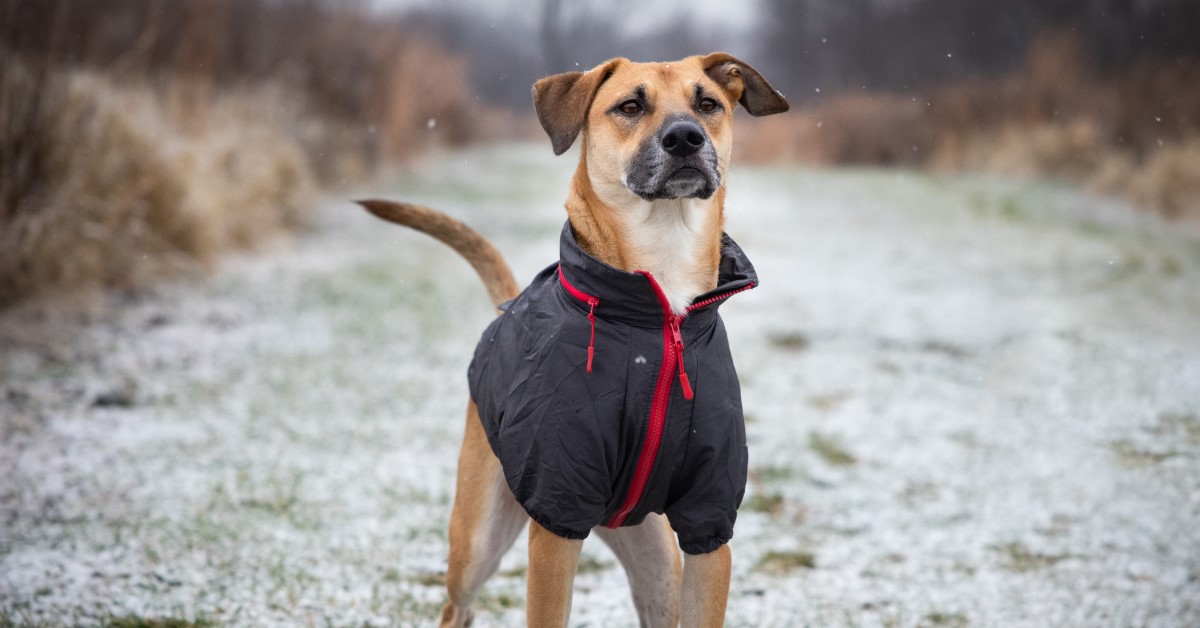Protect Your Dog in Snow & Ice this Winter
Keep your pet safe from the dangers of snow and ice this winter by following some simple safety tips.

Many dogs enjoy frolicking in the fresh snow after a winter storm. Some dogs even have thick fur coats that help protect them in frigid weather. However, pet owners must use caution when allowing their furry companions to spend time outdoors. Snow and ice pose some dangers to pets, especially with prolonged exposure. Learn how to protect your dog in snow and ice this winter season.
1. Keep Walks Short
Dogs need energy to stay in tip-top shape – both mentally and physically. Walking keeps pets healthy by promoting weight control, joint health, and urinary and digestive health. In the winter, getting enough time outside can be tricky due to the cold. It’s best to limit outdoor exercise to avoid threats like frostbite and hypothermia.
According to Beth Malinich, an accomplished vet at the Animal Hospital of Fairview Park, large dogs (50 to 80 lbs.) should spend no more than one minute per degree outdoors. Medium-sized dogs (25 to 50 lbs.) should be outside no more than 30 seconds per degree. Small dogs (15 to 25 lbs.) can withstand just 15 seconds per degree. Extra small dogs weighing less than 15 lbs. should only remain outside for up to 7 seconds per degree.
2. Clear a Safe Space
Just like humans, dogs can slip on a patch of ice and injure themselves. Create a safe space for your pet outdoors where he can walk around, do his business, and get some exercise. Clear off the porch or patio, as well as any steps leading to the yard. Shovel all walkways and driveways where your pooch might go.
Create traction for your pet by putting down sand or a non-toxic ice melt specifically formatted to be safe for pets. Avoid using traditional rock salt as it can cause burns on your dog’s paw pads.
3. Moisturize Paw Pads
Speaking of paw pads, your pet’s pads are most at risk for damage from the snow and ice. Winter weather can cause the pads to dry and crack, causing painful sores that can later become infected.
Before going outdoors, slather your pet’s paw pads with a thick layer of beeswax-based moisturizer. If you don’t have a designated paw balm, petroleum jelly will also do the trick. Moisturizer helps create a barrier that keeps ice and harmful chemicals off your dog’s sensitive paw pads.
4. Slide on Dog Boots
While many dogs do not enjoy wearing boots, a pair of dog shoes or booties can help protect their paws in snow and ice. Salt, sharp objects, ice shards, and other hazards can be hidden under the snow. Training your pet to wear dog boots can help protect them from the unknown and lower their risk of frostbite.
5. Trim Long Toenails
If your dog has long toenails, it may be time for a trim. Long toenails in dogs can cause a variety of problems during the winter months. First, long nails make it more difficult for your pet to maintain traction on slippery surfaces, increasing their risk of falling and suffering an injury.
Next, long toenails force the pads on your pet’s feet to splay open. Once open, snow and ice can quickly accumulate between the pads, creating discomfort and possibly injury.
6. Groom Pets Regularly
In the winter, dogs that spend time outdoors can attract bits of ice, ice-melting chemicals, salt crystals, and other substances on their skin and fur. It’s important to regularly groom your dog to eliminate these substances before they can cause damage.
After each walk or outdoor play session:
- Clean your dog’s paws with warm water and a cloth.
- Dry your pup off with towels to keep him warm.
Trim any excess hair growing around the paw area to avoid clumps of ice from sticking to your pet’s paws.
7. Provide Fresh Water
Pets require a clean and constant supply of freshwater, year-round. According to WebMD, the average dog requires approximately one ounce of fluids per pound of body weight per day.
If your dog doesn’t receive enough water during the day, he may decide to eat snow or water from melted snow. The problem with this is that snow can harbor dangerous chemicals and bacteria. Pet owners can avoid this risk by having a fresh supply of water available at all times.
8. Dress Your Pet Warmly
Not all dogs have a double coat to keep them warm when the weather drops below freezing. To help your dog retain body heat, consider dressing him in a sweater or coat. The right winter clothing can help keep your dog warm and comfortable while lowering the risk of injury and conditions like hypothermia.
When dogs are kept warm through proper clothing, their core temperature remains warm enough to maintain healthy circulation to the paws. However, you want to avoid clothing that is too tight or restricts movement.
9. Give Seniors Extra Care
Senior dogs require extra special care during the winter. They are often more susceptible to injury and disease and are more likely to heal slower if they are hurt outdoors.
Ensure that your senior dog has a warm and soft place to rest after coming in from the cold. It can also be helpful to give your senior pet a natural joint supplement to help lubricate their aging joints and ease any joint discomfort they may be feeling.
Don’t let the cold weather prevent you and your dog from enjoying the great outdoors. With the proper safety precautions, pets can safely venture into the snow.
Ready to start saving money on pet wellness care?
Then take a look at Mint Wellness, the pet wellness plan that provides fast reimbursement on routine pet care. Save on vaccinations, wellness exams, preventatives, dental, and more!
Learn More


